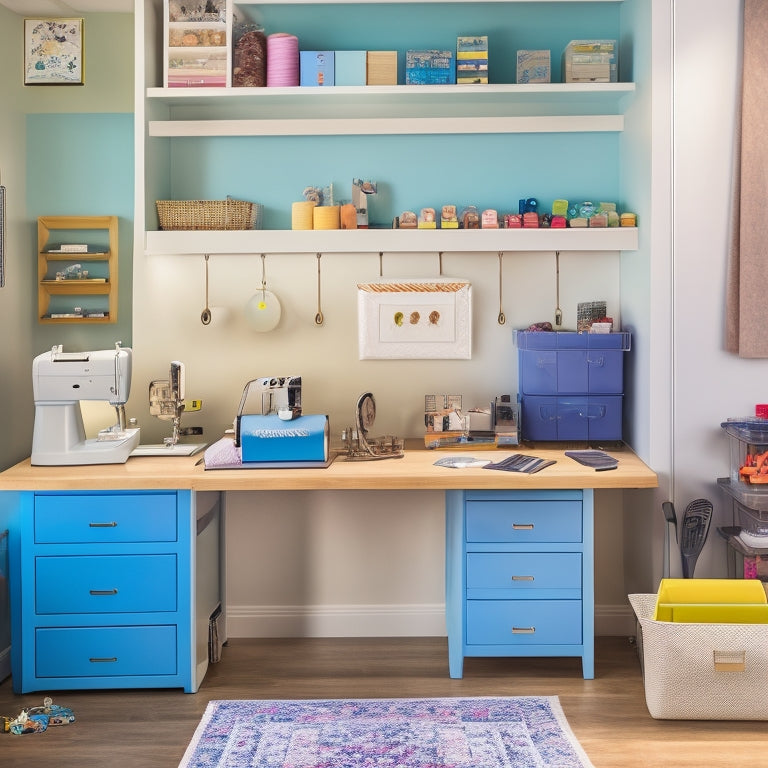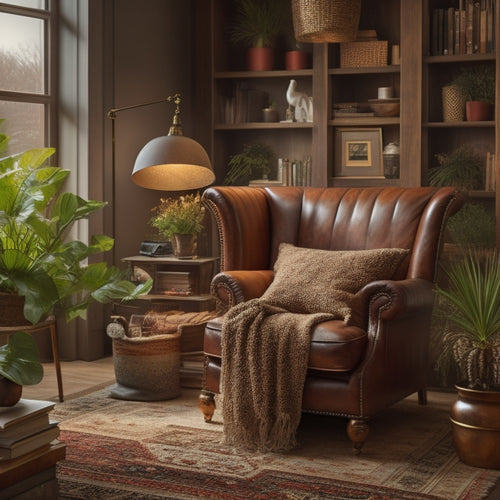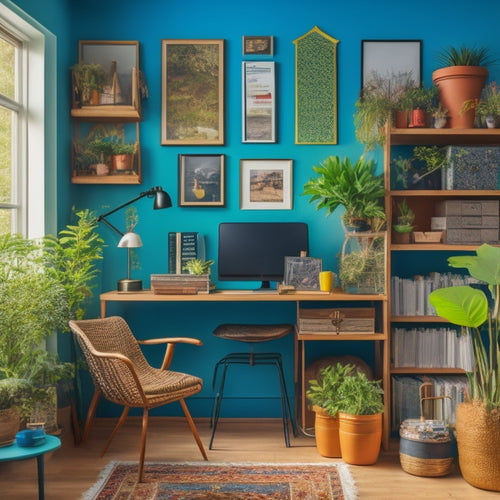
Maximize Your Mini Craft Room's Productivity
Share
You can boost your crafting productivity by up to 50% by optimizing your mini craft room's layout and organization. Start by purging unwanted supplies to free up space and declutter your mind. Utilize vertical storage with shelves, dividers, and pegboards to maximize storage. Designate zones for activities, and use labels for efficient organization. Implement a 'One In, One Out' policy to control supply intake. Schedule regular cleaning sessions and create a functional workstation with ergonomic chair, task lighting, and efficient tool organization. By following these steps, you'll be well on your way to a more productive mini craft room, and there's even more to explore to take your productivity to the next level.
Key Takeaways
• Purge unwanted craft supplies to free up space and declutter your mind, allowing for a more focused work environment.
• Utilize vertical storage space with shelves, dividers, and stackable bins to maximize storage capacity in a mini craft room.
• Designate specific zones for different activities and use labels to keep supplies organized and easily accessible.
• Implement a 'One In, One Out' policy to control supply intake and maintain a balanced and organized workspace.
• Schedule regular cleaning sessions to maintain a tidy and functional workstation, ensuring maximum productivity in a mini craft room.
Purge Unwanted Craft Supplies
What's holding you back from tackling that craft project you've been putting off - a cluttered workspace or an overwhelming stash of supplies? It's time to face the truth: you can't create in a space that's suffocating under the weight of unused materials. Purging unwanted craft supplies is the first step towards maximizing your mini craft room's productivity.
Supply sentimentalism can be a major hurdle. It's hard to part with items that hold memories or were expensive. However, if you haven't used it in a year, it's likely you won't miss it. Be honest with yourself - will you really use that bundle of dusty yarn or those faded stickers?
Donation dilemmas arise when you're unsure what to do with the supplies you're letting go of. Consider donating gently used items to local schools, community centers, or online crafting communities. You'll free up space, declutter your mind, and spread some creative joy.
Optimize Vertical Storage Space
Now that you've purged your unwanted craft supplies, it's time to make the most of your mini craft room's vertical storage space, where every inch counts. With careful planning, you can create a functional and efficient space that maximizes your room's vertical real estate.
Here are some strategies to help you optimize your vertical storage space:
-
Install shelves and use wall anchors to guarantee they're securely fastened to the wall, preventing them from tipping over.
-
Utilize shelf dividers to separate and categorize your supplies, making them easy to find and access.
-
Invest in stackable storage bins and baskets to store items like paper, fabric, and other crafting materials.
-
Consider installing a pegboard on a wall or the back of a door to hang frequently used tools and supplies.
-
Don't forget to use the space above your shelves by installing overhead storage units or baskets to store less frequently used items.
Designate Zones for Activities
As you set up your mini craft room, you'll want to designate zones for specific activities to maintain organization and focus.
You'll need a crafting station where you can work on projects, and separate areas for storing your supplies.
Crafting Station Setup
To optimize your mini craft room's productivity, designate specific zones for different activities, ensuring each area is tailored to its unique requirements. This strategic setup enables you to focus on the task at hand, maintaining a smooth crafting flow.
A well-designed station ergonomics promotes comfort and reduces fatigue, allowing you to work efficiently for extended periods.
Here are some essential considerations for your crafting station setup:
-
Work Surface: Choose a surface that suits your craft, such as a sturdy desk for heavy projects or a smooth countertop for delicate work.
-
Task Lighting: Position lamps or overhead lighting to illuminate your work area, reducing eye strain and improving visibility.
-
Ergonomic Seating: Invest in a comfortable, adjustable chair that supports your back and promotes good posture.
-
Tool Organization: Store frequently used tools within easy reach, minimizing distractions and saving time.
-
Inspiration Board: Create a visual board for ideas, reminders, and inspiration, keeping your creative juices flowing.
Supply Storage Areas
How can you efficiently store your craft supplies to maintain a clutter-free workspace and maximize productivity in your mini craft room? The key is to designate specific zones for different activities and allocate storage areas accordingly.
Start by categorizing your supplies into groups, such as paper crafting, sewing, and painting. Then, assign a specific storage area for each group.
Use supply baskets, craft cartons, and other containers to store items that you don't use frequently. Label each container so you can easily find what you need. Consider installing shelves or a pegboard to maximize vertical storage and keep frequently used items within easy reach.
Designate a specific area for your most-used supplies, like scissors, glue, and tape, to save time and effort. By organizing your supplies in this way, you'll be able to quickly find what you need, minimizing distractions and staying focused on your creative projects.
Utilize Multi-Functional Furniture
As you set up your mini craft room, you'll want to prioritize furniture that serves multiple purposes to maximize your space.
You'll find that incorporating multi-functional pieces, such as space-saving desks, foldable storage shelves, and vertical supply stations, will help you stay organized and focused.
Space-Saving Desk Options
You can exponentially increase your mini craft room's productivity by investing in space-saving desk options that serve multiple purposes. By doing so, you'll create a more efficient and organized workspace that allows you to focus on your craft projects.
Here are some space-saving desk options worth exploring:
-
Corner workstations: These desks are specifically designed to fit snugly into the corners of your mini craft room, providing a compact workspace while keeping the rest of the room open.
-
Ergonomic keyboards: Invest in an ergonomic keyboard tray that can be attached to your desk, allowing you to work comfortably and efficiently.
-
Wall-mounted desks: These desks can be folded up when not in use, providing additional floor space for other activities.
-
Compact workstations with built-in storage: These desks often come with built-in shelves, drawers, or cabinets, keeping your supplies organized and within reach.
-
Adjustable height desks: These desks can be adjusted to different heights, allowing you to switch between sitting and standing throughout the day.
Foldable Storage Shelves
Frequently, mini craft rooms benefit from incorporating multi-functional furniture, and foldable storage shelves are an excellent example of this principle, providing a convenient and space-saving solution for organizing supplies.
These shelves offer portable convenience, allowing you to easily move them around your craft room as needed. When not in use, they can be folded and stored away, freeing up valuable floor space.
When it comes to shelf styling, foldable storage shelves come in a variety of designs and configurations to suit your specific needs. You can choose from compact, single-tier options or larger, multi-tiered shelves to accommodate different types of supplies.
Some models even feature adjustable shelves, allowing you to customize the storage space to fit your unique requirements.
Vertical Supply Stations
What makes vertical supply stations a game-changer in mini craft rooms is their ability to maximize wall space while keeping essential supplies within easy reach. By utilizing multi-functional furniture, you can create a centralized hub for your crafting essentials, freeing up floor space and reducing clutter.
This thoughtful design approach allows you to work more efficiently, as everything you need is right at your fingertips.
When setting up your vertical supply station, consider the following key elements:
-
Label organizers: Use clear labels to identify contents, making it easy to find what you need in a snap.
-
Station ergonomics: Position your station at a comfortable height to avoid straining your back and neck.
-
Tiered shelving: Incorporate shelves of varying heights to accommodate supplies of different sizes.
-
Pegboard integration: Add a pegboard to hang frequently used tools and accessories.
-
Adjustable compartments: Incorporate adjustable compartments to customize your storage space as your needs change.
Implement a "One In, One Out" Policy
By adopting a 'one in, one out' policy, every new craft supply or tool that enters your mini craft room must be balanced by the removal of an existing one, ensuring a constant flow of organized creativity. This habit formation technique helps you maintain a clutter-free space, allowing you to focus on your projects without distractions.
By setting this boundary, you'll be more mindful of your purchases, thinking twice before buying something that mightn't be essential.
You'll also develop a habit of regularly reviewing your supplies, identifying what's no longer needed or useful, and letting go of items that are taking up valuable space.
This process will help you identify patterns in your crafting habits, allowing you to refine your supply collection and make more intentional purchasing decisions.
Schedule Regular Cleaning Sessions
Your mini craft room's productivity relies heavily on your ability to set aside dedicated time for cleaning and maintenance. By doing so, you'll cultivate a declutter mindset, ensuring your space remains organized and functional. Schedule regular cleaning sessions to keep your mini craft room in top shape. This will help you stay focused on your projects and avoid wasting time searching for misplaced supplies.
Here are some cleaning rituals to incorporate into your routine:
-
Set aside 10-15 minutes each day to tidy up your workspace
-
Designate one hour each week for deeper cleaning and organization
-
Create a 'to-donate' box to collect items you no longer need or use
-
Implement a 'one-touch rule' when cleaning, putting things away in their designated spot as soon as you're done using them
-
Make it a habit to clean as you go, wiping down surfaces and putting away supplies after each project
Create a Functional Workstation
Daily, you'll find yourself returning to your workstation, so it's essential that it's optimized for productivity. A well-designed workstation helps you stay focused and efficient, allowing you to complete tasks quickly and effectively.
Start by investing in an ergonomic chair, which will provide comfort and support during long crafting sessions. This will help reduce fatigue and prevent injuries.
Next, consider your task lighting. Essential lighting is vital for precise work, such as cutting, gluing, or painting. Install task lamps or under-cabinet lighting to illuminate your work surface, reducing eye strain and improving visibility.
Make sure your workstation is at a comfortable height, allowing you to work with ease. Keep frequently used tools and supplies within easy reach to minimize distractions and maximize your workflow.
Frequently Asked Questions
How Do I Handle Sentimental Craft Supplies I No Longer Use?
You're torn between holding onto sentimental craft supplies and freeing up space. Consider hosting a Supply Swap with fellow crafters or gifting items to Memory Keepers who'll appreciate their significance, allowing you to let go without guilt.
Can I Really Make a Mini Craft Room Work in a Small Closet?
You're wondering if a mini craft room can thrive in a small closet. The truth is, with a thoughtful closet conversion and strategic space optimization, you can create a functional haven that sparks creativity, even in the tiniest of spaces.
What if I Have Multiple Crafting Hobbies With Different Needs?
You're juggling multiple crafting hobbies with different needs, so you'll need to prioritize Hobby Segmentation and strategic Space Allocation to make sure each activity has its designated area, minimizing clutter and maximizing workflow efficiency.
How Often Should I Reassess My Craft Room's Organization System?
You should reassess your craft room's organization system every 2-3 months to make sure it adapts to your changing needs, incorporating a seasonal purge to refresh your space, and embracing its evolution to optimize your workflow.
Are There Any Specific Ergonomic Considerations for a Mini Craft Room?
As you nestle into your mini craft room, remember to prioritize your comfort, dear crafter! Make sure your chair height aligns with your desk space, allowing your arms to rest at a 90-degree angle, promoting ergonomic bliss and reducing fatigue.
Related Posts
-

Budget-Friendly Ideas for a Cozy Home Library
You can transform any space into a cozy home library without breaking the bank. Start by decluttering your book colle...
-

3 Best Online Courses for Home Organization Skills
You're just a few clicks away from a clutter-free home and a more efficient daily routine. Three online courses can h...

